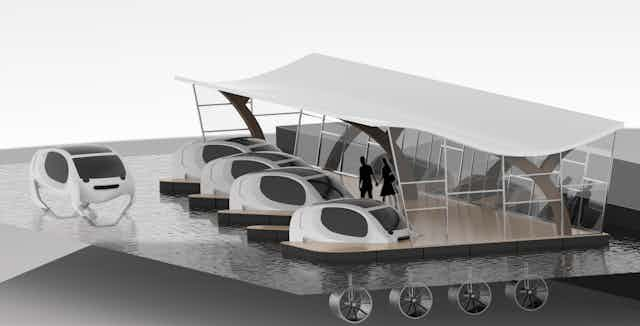The people of Paris could be using the waterways instead of roads, as early as summer. A new design concept called the Seabubble is due to be piloted in the French capital. The people behind the idea foresee a fleet of small electric hydrofoil taxi vehicles carrying passengers along the Seine, and much like a car sharing arrangement, its designers have even suggested they may be piloted by individual users.
Seabubbles, which can seat up to five people and are shaped like a car, employ proven hydrofoil technology which has been in use since Enrico Forlanini first baffled the inhabitants of Italy with it in the early 1900s.

Hydrofoil technology uses an underwater foil or arm which helps to lift the boat’s hull out of the water so that it can coast on the water’s surface. The drag reduction on these fast and efficient modes of water transport means a smoother ride – even in choppy waters. Larger hydrofoils are in use across the world. You can already catch a hydrofoil ferry in St Petersburg, Russia.
Commute by river
If these hydrofoil vehicles were adopted as a city transport, it would provide a fun, silent, electrically propelled and emission-free alternative to spending time in cars or buses on congested roads, or in the gloom of the Paris Metro system. Its designers are reportedly also seeking permission to use them on the Thames in London.
Paris already has an established and successful dry land equivalent in the electric car sharing scheme Autolib, so the Seabubble already has a lot going for it.
While the thought of using a water vehicle to get around a city with a 30-mile diameter may seem curious, let’s not forget that water has been used to travel across large cities for years. London, Venice, Hong Kong, Buenos Aires, New York, Auckland, and Rotterdam all use water buses and taxis of some description.
The river system in Paris snakes its way through the city in such a way that many important parts of town would be in easy walking distance from any moored boat. But as promising as this may be, there are still many unanswered questions.
Boat licences
Although water transport is used across the globe, they are all usually operated by a captain, and run along set routes, but Seabubbles’ designers propose that they could be driven by members of the public. Anyone operating a boat in France requires a boat licence. In fact, there are three different licence types, depending on the type of “driving” you intend to do. So whether there would be enough incentive for someone to embark on a lengthy and thorough training course is yet to be seen. It might make more sense for these to exist as a taxi service for most.
It’s fair to assume that navigating the waters would require some measure of seamanship since avoiding collisions with other Seabubbles and drifting objects would present a daily challenge. Larger vessels would also be a constant and inflexible presence on the Seine and if a large quantity of Seabubbles come into use, they will contribute significantly to the on-water traffic, of which there is already plenty.
Nevertheless, Seabubbles claim that compared to roads, there would be less objects to hit in the water and that their vehicle is easier to handle than a car. They also suggest that innovative detail solutions could take care of any likely gremlins. Technology such as sonar and sensors could be employed to “read” the water ahead and reduce engine performance when objects are spotted. Or an automatic parking function could self-moor the vehicles once they are within reach of their landing.
Maintenance and repairs
Seabubbles can reach a speed of 20mph, and although this is seemingly modest, it is actually quite respectable on water. However, water feels firmer at higher speeds so this can put strain on the vehicle body. The stresses on their gliding points are high, and their structure is subject to a high levels of vibration – meaning that hydrofoils require regular and extensive maintenance. This combined with high usage and a potentially changing, relatively inexperienced clientele, means they may come in for frequent repairs.
All this considered, the project already has the backing of the city of Paris. And if the French pilot phase goes well, some of these questions should be answered, and Seabubbles may well provide Paris with another attraction.

